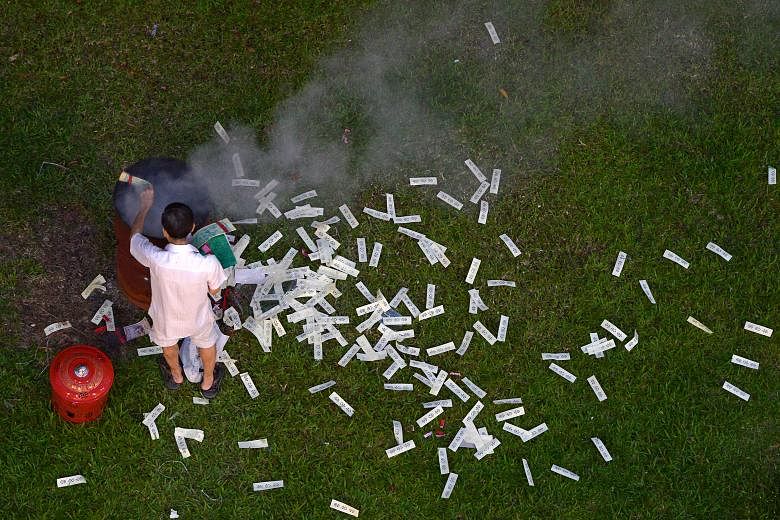You are not imagining it - air quality in Singapore gets worse during the annual Hungry Ghost Festival, and local scientists have found that the concentration of certain pollutants goes up by as much as 60 per cent during the festival.
Nanyang Technological University (NTU) scientists have discovered that concentrations of small pollutant particles known as PM2.5 increase during the festival, which runs from Aug 14 to Sept 12 this year. The particles include metallic elements such as lead and tin, and have been linked to health issues, including respiratory and cardiovascular diseases.
An analysis of air and rainwater samples between 2009 and last year showed that concentrations of individual PM2.5 elements rose by 18 to 60 per cent during festival months, compared with yearly mean concentrations.
In particular, nine metals considered hazardous air pollutants - chromium, manganese, nickel, cobalt, arsenic, cadmium, tin, antimony and lead - all showed average increases of 18 to 50 per cent during the festival. These are not considered hazardous for short-term exposure, although researchers noted that these were measured at the NTU sampling site, away from the sites of burning.
"People who are situated very close to the fires will inevitably breathe in higher amounts, although data is not available from these higher-risk sites," said NTU associate professor Richard Webster, who led the study.
If it's of some comfort, some town councils have been testing burners that produce less smoke and ash and the Taoist Federation has called for sensible burning of offerings like joss sticks and paper, which are burnt as a mark of respect to ancestors.
Despite the elevated elemental concentrations during the festival, these are still "significantly" less than the levels during high haze periods, when the Pollutant Standards Index readings cross into the unhealthy range (PSI>100).
All the elements detected in joss paper and incense, which include the nine hazardous substances, were among the PM2.5 elements that showed greater concentration levels during the festival months. The study appeared in last month's Environmental Science: Processes And Impacts journal.
Mr Tan Thiam Lye, the chairman of the Taoist Federation, said it held a meeting last month to get devotees to burn offerings responsibly. "We told them to moderate the amount of paper burnt - it is not a case of 'the more the merrier', it's sincerity that counts."
The National Environment Agency also advises devotees to clean up after they make their offerings and use containers and burning pits provided by town councils.
Some town councils, such as Nee Soon Town Council, are also trying out stainless steel burners that produce half the smoke and just 3 per cent of the ash, compared with the traditional red metal burners.
The NTU research hopes to shed light on the pollution caused by joss paper and incense - items known to generate large quantities of particulates, said senior research fellow Bahareh Khezri, one of the authors of the paper.
The next step is to collect data on organic compounds released during burning, which could be more toxic, said Dr Khezri."Burning joss paper and incense has been part of religious customs for thousands of years, but taking measures such as burning the items in a closed furnace, or using eco-friendly materials to produce the offerings, could help control air and water pollution. This could also reduce detrimental health effects."


